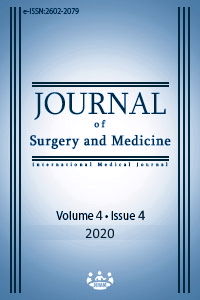Destroyed thyroid by acidic blood during subarachnoid hemorrhage: Experimental study
Keywords:
Subarachnoid Hemorrhage, Acidosis, Destroyed thyroid glandAbstract
Aim: Metabolic acidosis can negatively affect thyroid functions. The aim of this study is to show the damage in the thyroid gland caused by acidosis following subarachnoid hemorrhage (SAH).
Methods: Twenty rabbits were chosen from our recent SAH studies. Five healthy rabbits were included in the control group, five were included in the SHAM group, which received 1 ml of saline, and ten rabbits, chosen from SAH-induced animals with decreased blood pH, constituted the study group. TSH, T3, T4 and blood pH values were recorded before, during and after the experimental procedures. Densities of the normal and degenerated epithelial cell of thyroid glands were estimated using stereological methods. The relationship between blood pH and thyroid hormone values, and degenerated epithelial cell densities were analyzed statistically.
Results: pH values of blood were measured as 7.35 (0.037), 7.32 (0.05), and 7.21 (0.012) in the control, SHAM and SAH groups, respectively. The estimation of normal and degenerated epithelial cells per square milimeter of follicles was calculated as wall surface/cell surface. The mean normal epithelial cell count was 5,000 (750) in normal thyroid follicles. Mean degenerated epithelial cells counts were 50 (9) in the normal group, 154 (30) in the SHAM group and 460 (80) in the study group. For all results there was statistically significant difference between the control, SHAM and SAH groups (P<0.001).
Conclusions: Acidosis, one of the most fatal complications of SAH, may damage the thyroid gland with neurovascular network degeneration.
Downloads
References
Ozmen S, Altinkaynak K, Aydin MD, Ahiskalioglu A, Demirci T, Özlü C, et al. Toward understanding the causes of blood pH irregularities and the roles of newly described binuclear neurons of carotid bodies on blood pH regulation during subarachnoid hemorrhage: Experimental study. Neuropathology. 2019;39(4):259-67.
Bederson JB, Germano IM, Guarino L. Cortical blood flow and cerebral perfusion pressure in a new noncraniotomy model of subarachnoid hemorrhage in the rat. Stroke. 1995;26(6):1086-92.
Demirci T, Aydin MD, Caglar O, Aydin N, Ozmen S, Nalci KA, et al. First definition of burned choroid plexus in acidic cerebrospinal fluid-filled brain ventricles during subarachnoid hemorrhage: Experimental study. Neuropathology. 2020.
Välimäki M, Liewendahl K, Nikkanen P, Pelkonen R. Hormonal changes in severely uncontrolled type 1 (insulin-dependent) diabetes mellitus. Scandinavian journal of clinical and laboratory investigation. 1991;51(4):385-93.
Chan LY-S, Fok WY, Sahota D, Lau TK. Cord blood thyroid-stimulating hormone level and risk of acidosis at birth. European Journal of Obstetrics & Gynecology and Reproductive Biology. 2006;124(2):173-7.
Takahashi S, Mitamura R, Itoh Y, Suzuki N, Okuno A. Hashimoto encephalopathy: etiologic considerations. Pediatric neurology. 1994;11(4):328-31.
Mallipedhi A, Vali H, Okosieme O. Myxedema coma in a patient with subclinical hypothyroidism. Thyroid. 2011;21(1):87-9.
Mayfield RK, Sagel J, Colwell JA. Thyrotoxicosis without elevated serum triiodothyronine levels during diabetic ketoacidosis. Archives of Internal Medicine. 1980;140(3):408-10.
Molfino A, Beck GJ, Li M, Lo JC, Kaysen GA, Investigators F. Association between change in serum bicarbonate and change in thyroid hormone levels in patients receiving conventional or more frequent maintenance haemodialysis. Nephrology. 2019;24(1):81-7.
Akarsu M, Yoldemir ŞA, Altun Ö, Dikker O, Özcan M, Çil EÖ, et al. The effects of overt hypothyroidism on adipose tissue and serum betatrophin levels. Journal of Surgery and Medicine. 2019;3(9):631-4.
ahmad Mirboluk A, Rohani F, Asadi R, Eslamian MR. Thyroid function test in diabetic ketoacidosis. Diabetes & Metabolic Syndrome: Clinical Research & Reviews. 2017;11:S623-S5.
Rashidi H, Ghaderian SB, Latifi SM, Hoseini F. Impact of diabetic ketoacidosis on thyroid function tests in type 1 diabetes mellitus patients. Diabetes & Metabolic Syndrome: Clinical Research & Reviews. 2017;11:S57-S9.
Schlienger J, Anceau A, Chabrier G, North M, Stephan F. Effect of diabetic control on the level of circulating thyroid hormones. Diabetologia. 1982;22(6):486-8.
Castells S. Thyroid function in juvenile diabetes. Pediatric Clinics of North America. 1984;31(3):623-34.
Dürig J, Fiedler W, De Wit M, Steffen M, Hossfeld D. Lactic acidosis and hypoglycemia in a patient with high-grade non-Hodgkin's lymphoma and elevated circulating TNF-α. Annals of Hematology. 1996;72(2):97-9.
Kawashima H, Kraut JA, Kurokawa K. Metabolic Acidosis Suppresses 25-Hydroxyvitamin D 3-1α-Hydroxylase in the Rat Kidney: Distinct Site And Mechanism Of Action. The Journal of Clinical Investigation. 1982;70(1):135-40.
Bronner F. Calcium homeostasis. Disorders of mineral metabolism: Elsevier; 1982. p. 43-102.
Mizuno J, Yonenaga K, Mimura Y, Arita H, Hanaoka K. Hyperthermia and metabolic acidosis during subtotal thyroidectomy for a patient with Basedow's disease. Masui The Japanese journal of Anesthesiology. 2008;57(7):897-900.
Haas M, Reinacher D, Li J, Wong N, Mooradian A. Regulation of apoA1 gene expression with acidosis: requirement for a transcriptional repressor. Journal of Molecular Endocrinology. 2001;27(1):43-57.
Downloads
- 674 950
Published
Issue
Section
How to Cite
License
Copyright (c) 2020 Ozgur Caglar, Erdem Karadeniz, Sevilay Özmen, Elif Oral Ahıskalıoğlu, Mehmet Aydin
This work is licensed under a Creative Commons Attribution-NonCommercial-NoDerivatives 4.0 International License.
















